Sep 14, 2012 | Art Institute in Chicago, features, museums
Unfortunately I visited this museum on the last day of my trip to Chicago. Had I known how incredibly huge and impressive it is, I definitely would have dedicated double the time to soak all of it up.
Think of the most famous iconic artwork you can, and it’s probably sitting at the Art Institute. I felt like every corner I turned led me to another piece of art history – everything from “American Gothic” to tons of Picassos to van Gogh’s “The Room” – all of my favorites and a couple of new ones too.
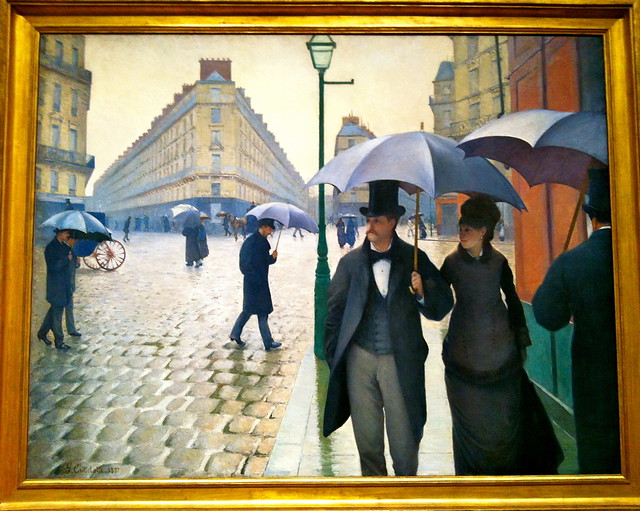 |
| Paris Street; Rainy Day by Gustave Caillebotte, 1877 |
 |
| American Gothic by Grant Wood, 1930 |

|
| New favorite! The Eventuality of Destiny by Giorgio de Chirico, 1927 |
It’s a funny thing finding a painting in a museum that you’ve studied and learned about through slides and textbooks. I imagine meeting up with someone from an online dating site would give you a similar feeling. Because you know so much about this piece and sometimes even the person who made it, which makes meeting it in person kind of phenomenal. Since its appearance never changes, I guess it’s more like meeting an old friend that always surpasses your expectations.
Whatever the feeling that I can’t do justice describing, it’s one I felt dozens of times at the Art Institute. Three straight floors of glass and slick pale wood was the perfect environment to see the works in; nothing extra where it wasn’t necessary. The rooms and hallways of beauty and masterpieces just kept coming and coming, so I’m just going to focus on my absolute favorites.
 |
| Nighthawks by Edward Hopper, 1942 |
The third floor European Modern Art gallery, from 1900-1950, was one of the greatest collections I’ve seen in so long. It could have been a substantial collection of work all on its own; maybe it’s own mini-museum. There were so many Picasso’s, Mattisse’s, and Dali’s – it always amazes me how much work those artists actually completed over the course of their lives, that they can be featured numerous times in hundreds of museums all around the world.
 |
| Detail of van Gogh’s The Room, 1888 |
American Modern Art was almost as great, well actually it was just as great, but in a different way. It’s really clear how different the styles of those two continents are after seeing these exhibits in succession. Right next to this space on the second floor was the featured exhibition, and when I visited I saw the Roy Lichtenstein retrospective.
I never really appreciated Roy Lichtenstein’s contributions until seeing this show, mostly because it was so hard for me to believe that they were actually oil paintings and not just pop art. But after seeing it as up close as the guards would let me, it was one part surprising and one part impressive to be wrong about how talented that man was. The show works chronologically, allowing us to really see how Lichtenstein developed his style and the different phases he went through during his progression as an artist. My favorite phase came later in his life, when he began to apply his own technique and style to the works of different artists and time periods. It really showed how great Lichtenstein had become – he had created such a unique visual language that could be applied to previous masterpieces, and it was so clear which aspects had come from where.
 |
| Masterpiece by Roy Lichtenstein, 1962 |
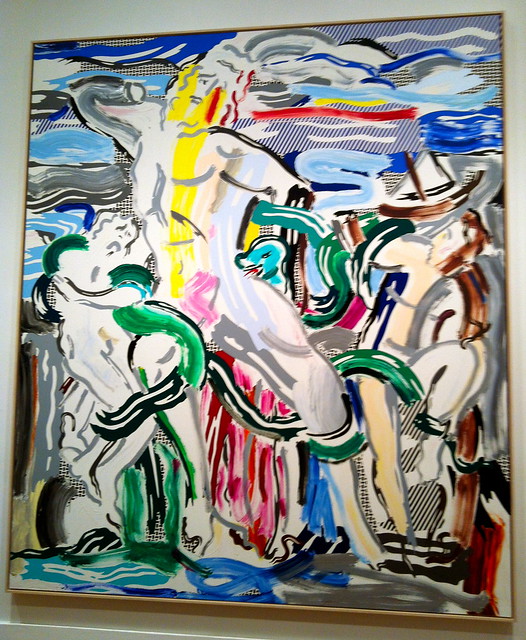 |
| Laocoon by Roy Lichtenstein, 1988 |
Someday soon I’ll visit the Art Institute again. Comment if you’ve been – I want to hear what you thought of it!
You can see more of my pictures from the Art Institute in my Flickr set here.
Sep 9, 2012 | music
This song is much more intense than Regina’s usual jam, but I think that’s what makes it so great – you’re not expecting it. And the best part is, the whole song’s about art! She’s lamenting over the captivity of masterpieces, destined to spend eternity locked away in museums because of how beautiful they are.

As a “free the art” kind of girl, I like to think that this song is about the selfishness of the museums, for hoarding away all these masterpieces and holding them ransom for admission prices. I personally believe that some material items exist in a sphere of magnificence above price – they’re too beautiful to be bought, and should belong to the people. Of course, since the museums can’t go giving each of us a Van Gogh or a piece of the Dead Sea Scrolls, their responsibility is to keep these items safe; to preserve them for us and our children and our children’s children.
But no matter what, these works should always belong to the collective society, who put up with things like visiting hours because that’s bearable to exchange for our masterpieces’ safety, plus we can’t expect museum workers to have an overnight shift. But things like outrageously high admission prices and “museum storage” are things we shouldn’t have to put up with. The museum doesn’t need $20 from an art student who wants to draw after the Greek greats, and it shouldn’t ever NOT be showcasing a work of art that we deserve to see. If they’re not going to have it on display, they should donate it to a smaller museum that will. I get that you like to rotate some exhibits to “keep things fresh,” but your need to have new items in your next email newsletter is not a good enough reason to hide priceless, timeless items from some of the greatest civilizations and people who ever lived.
So that’s what I like to think Regina is singing about in this song, but I know it can’t be that specific. I don’t know where the rowboats are trying to row off to, but nothing lasts as long as the stuff as museums, so maybe it’s just a desire to be mortal – to be real. Maybe they miss the artists who made them and died centuries ago, or maybe instead they represent those artists and that’s why it’s nothing but a mausoleum… And that’s why this song it so great.
Check out Regina’s “All the Rowboats” music video and lyrics below.
What do you think she’s singing about?
All the rowboats in the paintings
They keep trying to row away
And the captains’ worried faces
Stay contorted and staring at the waves
They’ll keep hanging in their gold frames
For forever, forever and a day
All the rowboats in the oil paintings
They keep trying to row away, row away
Hear them whispering French and German
Dutch, Italian, and Latin
When no one’s looking I touch a sculpture
Marble, cold and soft as satin
But the most special are the most lonely
God, I pity the violins
In glass coffins they keep coughing
They’ve forgotten, forgotten how to sing, how to sing
First there’s lights out, then there’s lock up
Masterpieces serving maximum sentences
It’s their own fault for being timeless
There’s a price to pay and a consequence
All the galleries, the museums
Here’s your ticket, welcome to the tombs
They’re just public mausoleums
The living dead fill every room
But the most special are the most lonely
God, I pity the violins
In glass coffins they keep coughing
They’ve forgotten, forgotten how to sing
They will stay there in their gold frames
For forever, forever and a day
All the rowboats in the oil paintings
They keep trying to row away, row away
First there’s lights out, then there’s lock up
Masterpieces serving maximum sentences
It’s their own fault for being timeless
There’s a price to pay and a consequence
All the galleries, the museums
They will stay there forever and a day
All the rowboats in the oil paintings
They keep trying to row away, row away
All the rowboats in the oil paintings
They keep trying to row away, row away…
Sep 8, 2012 | news, political art
The Divided State of America is a collection of huge spray paintings by renowned artist Chor Boogie, all with representations of the issues we’re facing in modern politics. The exhibition was shown throughout the Democratic National Convention in Charlotte, NC, with all events hosted by entrepreneurs.
They also hosted a symposium yesterday afternoon during the convention, gathering prominent minds in different fields and asking them fundamental questions about why America is so polarized right now ,and how we can resolve all these huge differences before the election.
This collection will also feature at a later series of public events around the country in preparation for the presidential election in November.
For more info check out their Facebook page here.
And you can read the original story on BrooklynStreetArt.com here.
*****************************************************************************************************************************************************************
They’re powerful images for sure, almost too violent – although I suppose it could be argued that the current state of things warrants all that harshness.
I spent a good part of yesterday catching up on all the major speeches from both conventions, and the differences in the rhetoric were absolutely ridiculous. It was like they were speaking two different languages.
Like with climate change: Mitt Romney made a sarcastic face 16 seconds too long while everyone in the room cracked up at the “sea level rising” – and Obama treats that same issue with the seriousness and respect of our children’s futures.
The differences are too big now. The gulf is so wide that understanding and compromise now seem so impossible, because hard-heartedness and violence has filled up that space.And these spray paintings by Chor Boogie certainly have that intense quality to them. Almost like propaganda for a war. It’s them versus us – the powerful few against the less powerful many.
 |
PAIN AT THE PUMP
One side advocates the use of nuclear power and the expansion of oil drilling. The other for the construction of windmills and solar panels. And yet, both solutions are not enough – waning resources are insufficient to support America’s continued consumption, and the economy is suppressed by Wall Street, continuing wars, and our unsustainable growth. The same gas that fuels American productivity forms the noose that may one day hang us.
Can America pledge allegiance to finding sustainable solution? |
 |
ANNUIT COEPTIS
On every dollar bill, the Great Seal of the United States seals our fate with Annuit Coeptis, Latin for “He approves of the undertakings.” Since the Citizens United decision, centers of power – not the individual – approve of the undertakings of American politicians over the heads of working citizens. Atlas-like Americans have been rendered silent by this influence in a society intended to be of the people, by the people, for the people.
How do we restore the voice of the people as the political authority in the United States? |
 |
THE PURSUIT OF HAPPINESS
For a nation built on the idea that all men are created equal, prejudice divides us at the polls and on the streets. Gone are of Lincoln’s log cabins and the fifty years since we sent man into space, and yet our youth are still targeted by “the man” and his manmade means of oppression. The Pursuit of Happiness remains in fierce competition with the deadly forces of injustice, prejudice, and inequality.
How can all Americans be truly endowed with the inalienable rights of life, liberty, and the pursuit of happiness? |
**All captions and images from the Divided State of America Facebook page here.
Sep 6, 2012 | Brooklyn Museum, sculpture
 Suddenly coming upon this grand tree in the middle of a museum hallway was a stunning experience, in every use of the word. It wasn’t until I walked around it that I saw the even grander piano containing its massive trunk. The wood of the piano and the bark of the tree looked like they had been fused together over time, until the piano seemed to nearly reach its original state, as a tree that once lived too. Almost like the tree was claiming back the brother that we’d stolen away to saw down and polish off.
Suddenly coming upon this grand tree in the middle of a museum hallway was a stunning experience, in every use of the word. It wasn’t until I walked around it that I saw the even grander piano containing its massive trunk. The wood of the piano and the bark of the tree looked like they had been fused together over time, until the piano seemed to nearly reach its original state, as a tree that once lived too. Almost like the tree was claiming back the brother that we’d stolen away to saw down and polish off.
The piano is actually a working keyboard, and when turned on it plays the song “Strange Fruit,” in a version written by the artist. It was a song made famous by Billie Holiday in the late 1930s, as a protest against lynching and hate crimes. It has a dark, ominous tone and moves slowly along from note to note. Unfortunately the piano wasn’t turned on when I visited so we didn’t get to hear the artist’s interpretation of this severe somber song. The lyrics included on the placard read:
Southern trees bear strange fruit,
Blood on the leaves and blood at the root,
Black bodies swinging in the Southern breeze,
Strange fruit hanging from the poplar trees.
But when I first saw the tree, my initial reaction took me to a very different tune. I immediately thought of Regina Spektor’s song “Firewood,” from her new album What We Saw from the Cheap Seats. In it she repeats the line “The piano is not firewood yet,” as a way of recognizing the life and potential that still remains within all of us, regardless of our age. It’s such a happy, uplifting song – even though Regina sings it sweet and soberly. Applying that song to this sculptural work seems to only make the message even more uplifting. As if the wood of the piano was destined for beautiful musical means, and now that it has become the piano it was always meant to be, it’s come to share this newfound music with the rest of the trees. Her song goes:
The piano is not firewood yet,
They try to remember but still they forget
That the heart beats in threes, just like a waltz
And nothing can stop you from dancing
Pick one of the two songs I talked about and scroll through the pictures below while you listen.
Try out the other song too if you like, just to see how different two interpretations can make things.

All of these photos were edited using the “Yellowed” filter on Picfull. The tree was in a poorly-lit area in the museum so the originals didn’t turn out how I wanted. But they’re saved towards the end of this Flickr set if you still want to see them!
Sep 4, 2012 | Brooklyn Museum, features, museums
 This post was meant to precede the Brooklyn Museum’s Target First Saturday this past weekend, but as it turns out, they didn’t even have it this month because of the West Indian-American Day Parade. The first Saturday of every month, the Brooklyn Museum allows free admission for everyone, and hosts a number of (pretty rowdy) events from 5pm-10pm, sponsored by Target.
This post was meant to precede the Brooklyn Museum’s Target First Saturday this past weekend, but as it turns out, they didn’t even have it this month because of the West Indian-American Day Parade. The first Saturday of every month, the Brooklyn Museum allows free admission for everyone, and hosts a number of (pretty rowdy) events from 5pm-10pm, sponsored by Target.
But truth be told, the Target First events are pretty distracting from the art you’re there to see. The museum was packed full when I visited on the first Saturday of August, and it’s clear that most everyone is there for the drinking and music, with very few people bothering to look at all the beautiful things surrounding them.
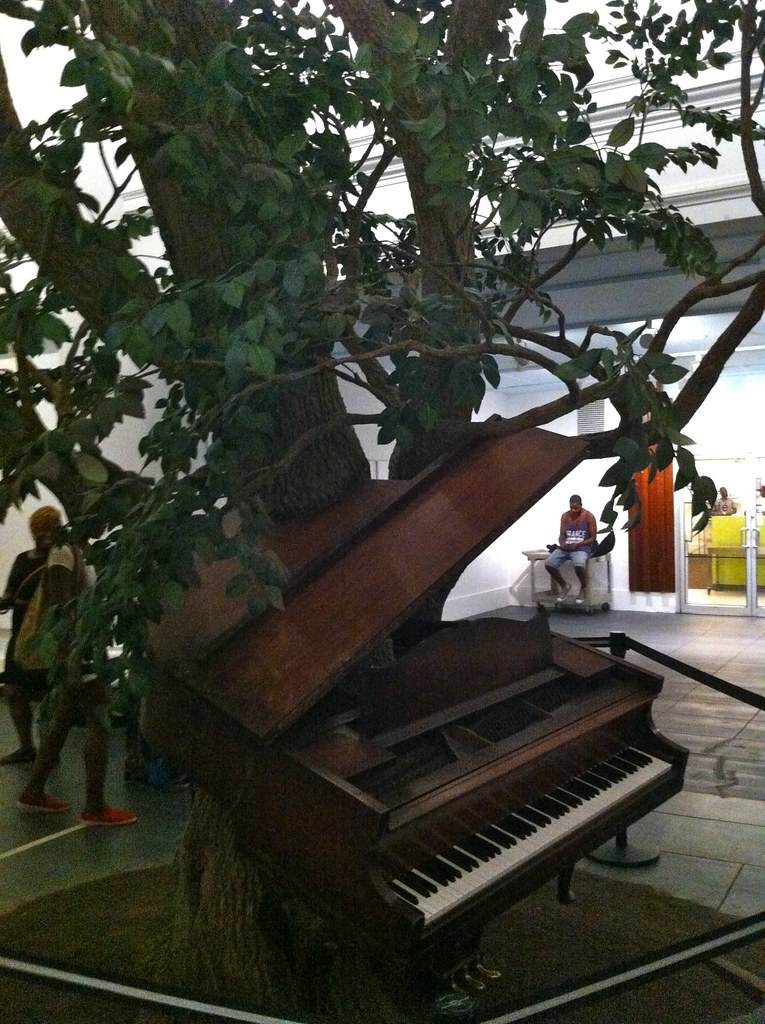 |
Blossom
by Sanford Biggers, 2007 |
The outside of the building is incredible – neoclassical architecture reminiscent of the Met, with statues of Old Testament prophets and Greek philosophers lining the exterior. You’d never guess that the inside is fully modernized with glass panels and exposed brick leading you into the center lobby that all the art revolves around.
 |
Maximum Sensation
by Mounir Fatmi, 2010 |
The first floor’s Great Hall exhibit is overwhelming. They’ve collected and curated pieces that in no way go together, but it’s interesting to compare these works that came from completely opposite times and cultures. They call it, Connecting Cultures, A World in Brooklyn and it focuses on three simplistic themes: connecting places, people, and things, with juxtaposed artworks for each section. One of my favorite pieces from the whole museum was sitting just outside this exhibit: a piano (working keyboard included) with a tree growing up out of the center of it. It’s called “Blossom,” and could have only been more beautiful if the tree was actually real.
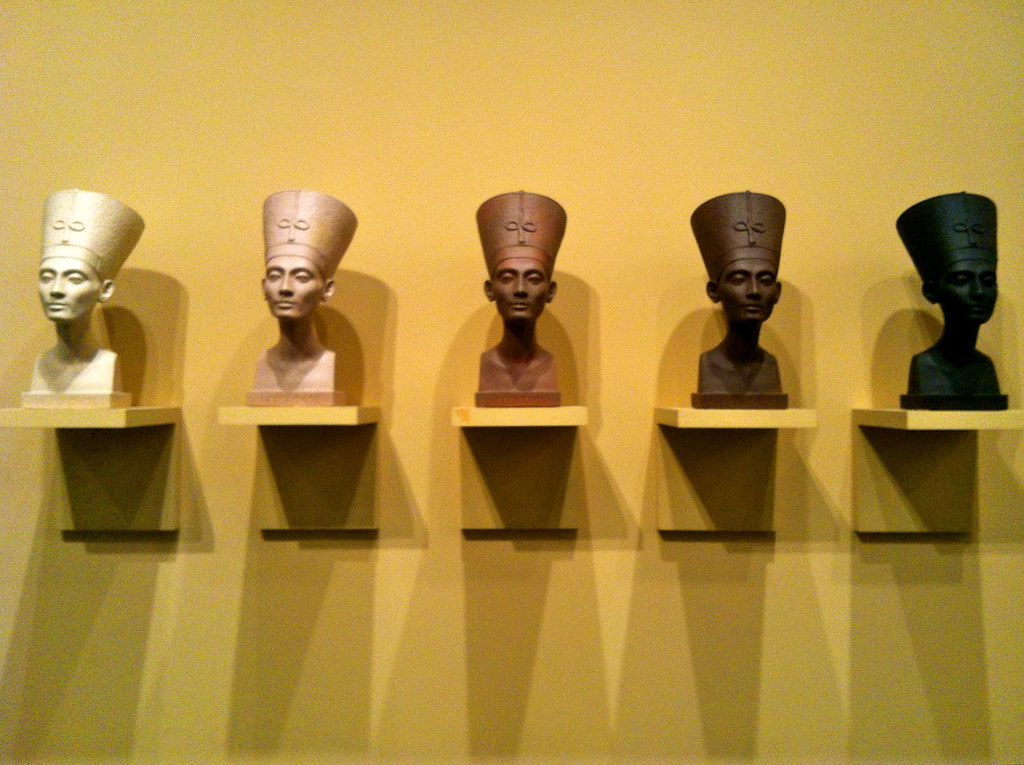 |
Grey Area (Brown Version)
by Fred Wilson, 1993 |
The first floor is also home to a pretty extensive collection of African art. The art of Asia and the Isalmic World finds a home on the second floor, and they have nearly a whole floor’s worth of Ancient Egyptian work, complete with decorated walls and ceilings matching the ancient vibe. The third floor also has a fantastic collection of European art surrounding the open court below. It’s separated by country, with translations of each description, determined by the nationality of the artist.
The fourth floor has a lot of great contemporary pieces also circling the open court, one floor directly above the European paintings. Here you can find Mounir Fatmi’s “Maximum Sensation” from 2010: beautifully decorated felt-covered skateboards skattered about on the floor. Walk a bit farther and there’s Fred Wilson’s “Grey Area (Brown Version)”, five different solid shades of the iconic Cleopatra bust lined up in the center of an alarmingly yellow wall from lightest to darkest.
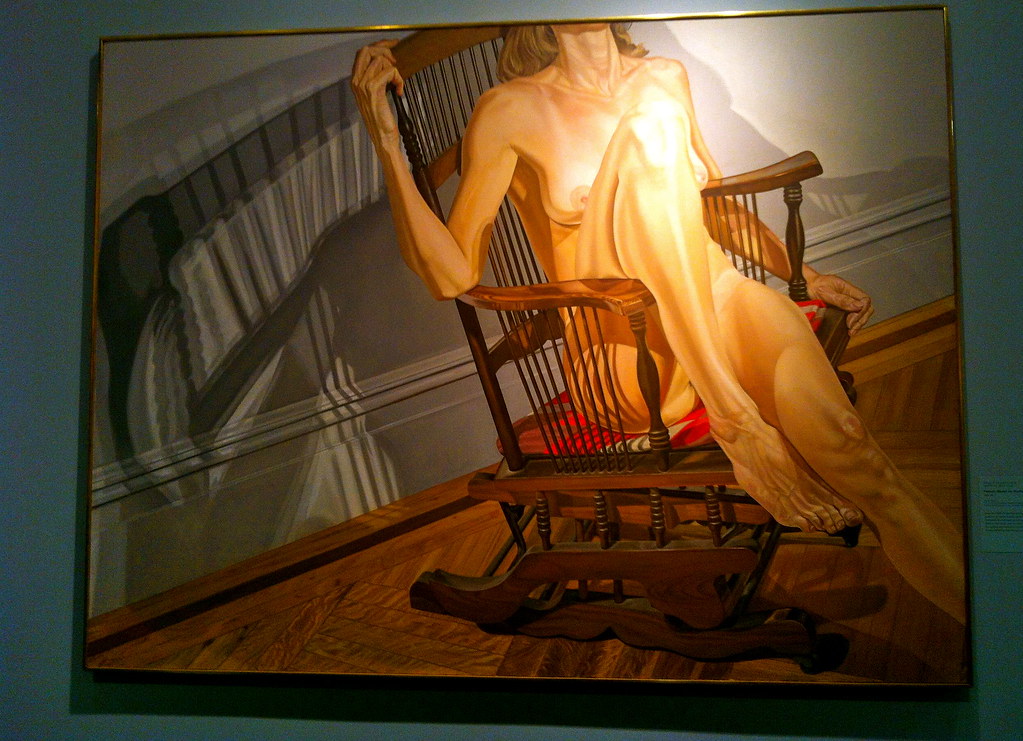 |
Female Model on a Rocker
by Philip Pearlstein, 1977-78
American Art, 5th floor |
|
|
On the fifth floor is the Luce Center for American Art, with everything from Native American artifacts to portraits of George Washington; everything from sixteenth century to contemporary American work. The most remarkable part of the museum is here on this floor: the Brooklyn Museum’s Visible Storage Center, where you can see all the works not on view, organized by numbers in clear glass cases. There’s shelves upon shelves of sculptures and rows upon rows of paintings, plus computer screens where you can search for anything you might be looking for. There’s even smaller, more fragile works stored in protective metal drawers.
I loved being taken behind the scenes in this special exhibit, and I honestly believe it’s something every larger-scale museum should have. If the works aren’t being used in a particular themed gallery, that doesn’t mean your visitors should be kept from them, especially since it’s just museum management’s decision to hide them away. Share all your art all the time – because why not?
See all my Brooklyn Museum photos in the Flickr set here.





























